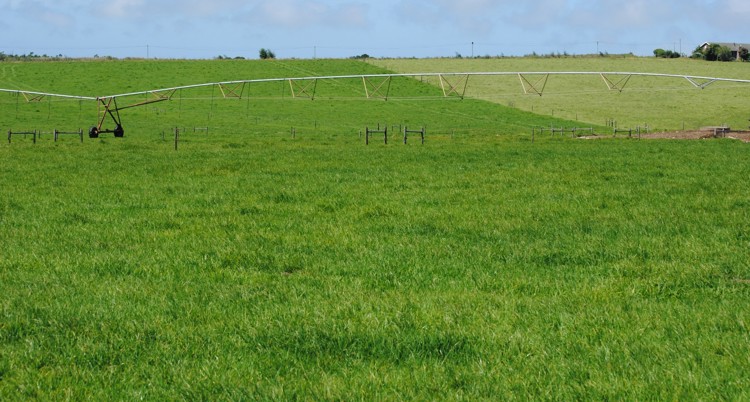
- Maximum production
- Maximum utilization
- Maximum lifespan
Pasture management for optimal utilization
There are several approaches or practices regarding the use of rye grass pastures, namely:
- Utilization based on a rotation system.
- Utilization based on the plant height
- Utilization based on the production of DM (dry material)
Each of these approaches has their own practical advantages, but the disadvantages to the plant and the animal derived from these practices may overshadow the benefits. The optimal utilization of the plant lies between the minimum grazing interval (2-leaf stage) and the maximum grazing interval (3 – 3.5 leaf stage).
Figure 1. Pasture growth curve
Research has shown that if rye grass is cut at a three-leaf stage versus at 2 and 4 week intervals, a greater DM yield is obtained. The number of tillers, leaves and roots per plant had also increased and the invasion of undesirable plants had decreased. The longevity of the rye grass had also increased, especially during the summer months.
The following factors play a critical role in grazing management to achieve optimal utilization, i.e. grazing intervals, intensity and duration of grazing. Before we look at these factors, there is another important factor that plays a major role, namely, the load (number of animals) placed on the pasture.
Figure 2
Figure 3
Figure 4
It is generally accepted that the use of pastures increases as the number of animals per hectare is increased (Figure 2), but there is a critical turning point where further increases will lead to a minimal increase in utilization as can be seen in Figure 3. The increase from 3.7 to 4.7 cows per ha is associated with a minimal increase in DM utilization.
This may cause a decrease in milk production and result in a decrease in the condition of the animals and be detrimental to the quality and longevity of the pasture. If the carrying capacity of the pasture is exceeded it will lead to a decline in profit (Figure 4). The decline in profit is brought about by overconsumption together with a concomitant decrease in the quality and the lifespan of the pasture. Another result is too little DM for the number of animals and the consequent "purchase of hectares," in other words, the addition of supplements. This practice was quite common in South Africa when the difference between milk price and concentrate price was large and it favoured the price of the milk.
‘Hectares’ in the form of concentrates could be profitably purchased and stored in a silo to compensate for poor quality pasture or shortages of DM
Penno connected DM tonnes to the live weight of cows to determine the carrying capacity of a pasture. In order to produce 5 700 kg of milk during lactation, the carrying capacity is determined by 1 tonne of DM per 90 kg live weight. The following is a practical example of how this is determined: If Jerseys are put on 100 hectares (16 tonnes DM / ha) of rye grass and 200 ton concentrates is purchased per annum, what will the carrying capacity be? The feed and rye grass contains about 11 MJ energy that may be metabolized. A 400 kg Jersey cow will thus be utilizing 4,44 tonnes DM during lactation. Therefore the total DM production is 1 600 + 200 = 1 800 tonnes. 405 Jerseys can be kept on 100 hectares or 4,05 Jerseys per hectare can be kept. This carrying capacity applies only to the dairy cow platform and additional provision should be made for the rest of the herd. For Holsteins weighing 550 kg the carrying capacity will be 2,94 cows per hectare. This general guideline is obviously dependent on many factors, of which grazing management and pasture quality are the most important factors. In order to optimize pasture management we shall now consider grazing intervals, intensity and duration.
Intervals
By making use of the minimum and maximum grazing intervals with rye grass, errors such as the genotype of the crop, cultivar, soil fertility and climate, may play a major role in pasture systems as opposed to fixed rotations, in which these variables are eliminated.
If rye grass is grazed during the two-leaf stage and younger there may be a decrease in DM yield as a result of the formation of fewer blades/ leaves, accompanied by the death of roots, fewer plants to survive plant stress such as heat waves and increased weed pressure on the pasture. If the rye grass is grazed later than the three-leaf stage, wastage occurs due to the death of the oldest leaves. The quality of the pasture decreases because of stem formation that occurs as a result of a lack of light with the possibility of an increased fungal pressure on the plants.
By making use of the minimum and maximum grazing intervals with rye grass, errors such as the genotype of the crop, cultivar, soil fertility and climate, may play a major role in pasture systems as opposed to fixed rotations, in which these variables are eliminated.
Intensity
The ideal grazing height is between 4 cm and 6 cm When pastures are grazed to less than 4 cm height, it may well happen that an initial increase in leaf formation occurs, but it is soon overshadowed by a decrease in DM due to the depletion of the plant's water-soluble carbohydrates and thus the plant's ability to recover. This may result in exposed soil and in the warmer months it may lead to elevated soil temperatures with the consequent death of more plants. Where too much stubble is left on the paddocks regrowth will occur faster, but the half-eaten leaves will die back and their ability to photosynthesize is not as strong as that of young new leaves. There is still a waste of energy, because the new leaves have to grow from ground level and shortages of light, as a result of too much stubble, may harm the process.
Duration
A particular pasture should not be grazed for more than two consecutive days. If the pasture is large and it has to be done the areas already grazed should be made inaccessible, because the sprouts are grazed that have developed from reserve carbohydrates and these reserves are then depleted, resulting in the death of new leaves.
